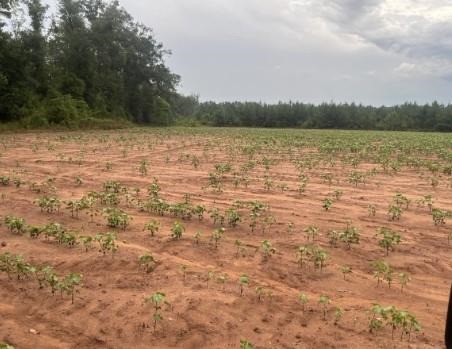As Alabama Cooperative Extension System agents and specialists travel the state of Alabama and talk to farmers and others involved in production row crop agriculture, one common theme arises in every region of the state.
Whitetail deer are a major threat to production. Alabama is blessed with a beautiful landscape, from the sandy beaches of the Gulf to the Appalachian Mountains in Jackson County. However, much of this landscape results in smaller fields—the average cotton field in Alabama is around 21 acres. These small fields are perfect safe havens for deer to feed in the evenings, often surrounded by woods on at least three sides. In these protected areas, deer can browse and damage thousands of seedlings in a single evening. To get a better understanding of which crops are affected, how much damage is being done and strategies are being used to mitigate losses, the Alabama Extension Crops Team conducted a survey with farmers across the state. To date, 58 farmers representing 36 counties have responded to the survey.
Survey Results
When asked which crops were affected by deer damage, producers listed cotton as the most affected crop (17,653 acres), followed by soybeans (10,490), peanuts (4,987), and corn (3,915). Additional crops, such as sweet potatoes, grain sorghum, wheat and rye represented 705 acres. In total, survey respondents reported 37,750 total acres of row crops affected, an average of 317 acres per farmer.
For reference, the USDA State Agriculture Overview reported an average farm size of 213 acres in 2021. Not only is this issue widespread, it is also consistent. When asked how often deer are a problem on the farm, 95% of respondents selected “every year” while 3% selected “every couple of years,” 2% responded “rarely,” and none responded “never.”
In addition to which crops are affected and how often, farmers were also asked to report what percent yield loss they estimate are lost to deer affected acre, based on differences in yields from affected and non-affected areas. Deer caused an average of 33% yield loss across responses with a range of 0-100% loss reported. Finally, farmers were asked to estimate the cost per affected acre from deer, in terms of yield losses and cost of mitigation strategies. The total losses reported across the respondents was $10,932,195.95. The average loss was $289.59 per acre, ranging from $23 to $1,200 per acre.

Other Issues Deer Cause
In addition to yield losses directly attributed to feeding from deer, other considerations must be made. One respondentground-level view of whitetail deer damage reported that shed deer antlers cause an average of two ruined tractor tires each year. One tire costs approximately $3,000 to replace.
Deer also cause issues with the logistics of replanting. In addition to costs associated with replacing seed, fuel for the tractor and labor in planting, the time it takes when farmers need to be doing other things, like applying herbicides or insecticides is critical. One farmer reported having to replant 235 acres due to deer in 2022.
Other issues include slight tolerances or intolerances to deer damage. Cotton and soybean, for example, are highly susceptible to deer damage because the terminal (or main growing point) is above ground as soon as the seedling emerges. Deer can bite off the terminal and kill the plant or cause unusual growth that may not yield as well or be as easy to manage later in the year. Some farmers resort to planting corn in high pressure areas every year. Without the ability to rotate crops, overall yield potential of the corn is reduced, before deer issues even start.
Current Mitigation Strategies
The main theme given when asked what strategies farmers are using to mitigate losses: nothing works. Farmers responded that they try deer repellents, sprays that use smell or taste to deter feeding. The problem is after a few days or a rain all of the effects are worn off. While some farmers apply for permits that allow deer to be killed in fields during the growing season, this strategy seems to be fruitless. Farmers tire from working all day in the fields and spending all night shooting deer to prevent damage.
While placing high fences around fields would likely help, they are expensive to build and could cause issues with moving farm equipment in and out. Additionally, farmers that rent land have little incentive to pay for fences around farms that they may not be able to work long enough to recoup the cost of the fence.
What to do?
One thing that Extension professionals do not want to do is bring attention to a major problem without any solutions. While there are not currently many solutions, one Alabama Extension regional agent has done some demonstration work across the state with promising results.
Eddie McGriff, an agent in Northeast Alabama, has had success planting sunn hemp as a buffer or border trap crop for deer. Sunn hemp is a summer legume with prolific growth, even under intense deer pressure. One demonstration with Nick McMichen, a farmer in Cherokee County, provided positive results in 2021. Over the previous few seasons, McMichen had a 40-acre field that consistently only produced on about 20 acres due to such high deer pressure. In 2021, a 40-foot border of the field was planted on one end of the field in sunn hemp as a trap crop. In that season, only approximately two acres of the field was lost as deer fed primarily in the sunn hemp. To make this work, the sunn hemp must be planted before the cash crop so that it is growing and is attractive to deer while the cotton crop is being established.
There are still more questions and concerns about deer management in Alabama row crops. Many famers report this as the most important pest they face because we have very few effective options to manage this pest.
Source : aces.edu